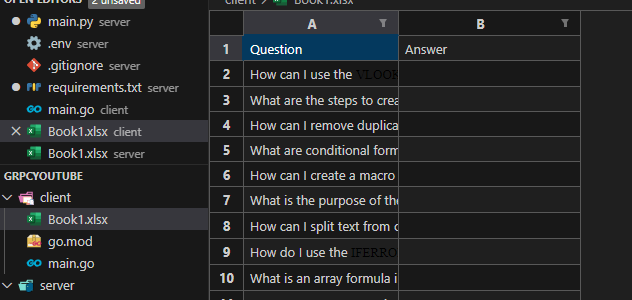Go と Python 間の gRPC 通信
- WBOYオリジナル
- 2024-08-22 19:02:33764ブラウズ

gRPC は、強力で高性能なリモート プロシージャ コール (RPC) フレームワークであり、REST ほど一般的には使用されていませんが、特定のシナリオでは大きな利点を提供します。
さらに、言語に依存せず、あらゆる環境で実行できるため、サーバー間通信に理想的な選択肢となります。
詳しくは説明しませんが、gRPC の一般的なリンクは次のとおりです。実践的なチュートリアルを提供します
gRPC クライアントに移行する
私たちの Go はクライアントですが、フロントエンド アプリ React、Svelte などのサーバーであることをイメージしてみましょう。
func getFirstArg() (string, error) {
if len(os.Args) < 2 {
return "", fmt.Errorf("expected 1 argument, but got none")
}
return os.Args[1], nil
}
func main() {
filePath, err := getFirstArg()
if err != nil {
log.Fatalf("Failed to get file path from arguments: %v", err)
}
fileData, err := ioutil.ReadFile(filePath)
if err != nil {
log.Fatalf("Failed to read file: %v", err)
}
...
}

例として、React フロントエンドはファイルをアップロードし、Go でそれを処理しますが、Excel からの回答が必要なので、GPT API を使用します。 Go でも実行できますが、一方で Python には、langchan_openai、Excel 用のパンダなど、私たちの生活を楽にするパッケージがたくさんあります。
できれば virtualenv .venv に gRPC をインストールすることから始めましょう
$ go install google.golang.org/protobuf/cmd/protoc-gen-go@latest $ go install google.golang.org/grpc/cmd/protoc-gen-go-grpc@latest $ export PATH="$PATH:$(go env GOPATH)/bin"
次に、OS にプロトコル バッファをインストールする必要があります。
プロトコル バッファ ファイルを保存する proto ディレクトリを作成しましょう。それに excel.proto という名前を付けて、これを貼り付けます:
syntax = "proto3";
option go_package = "client-gRPC/proto";
service ExcelService {
rpc UploadFile(FileRequest) returns (FileResponse);
}
message FileRequest {
string file_name = 1;
bytes file_content = 2;
}
message FileResponse {
bytes file_content = 1;
}
この gRPC サービスである ExcelService を使用すると、クライアントは名前と内容を送信してファイルをアップロードできます。サーバーは同じファイル内容で応答します。
Go の場合、Python で go_package を渡すことが不可欠です。この行は必要ありません。
vscode-proto3 は、VSCode を使用する場合にダウンロードするのに適した拡張機能です。
これらすべてが完了したら、proto ファイルを生成できます。prot dir と同じレベルに置くことをお勧めします。そのためには、次のコマンドを実行します。
プロトコル --go_out=。 --go_opt=paths=source_relative --go-grpc_out=。 --go-grpc_opt=paths=source_relative proto/excel.proto
成功すると 2 つのファイルが生成されますが、多くの調整がある場合はオプションで Makefile を追加し、proto + upper コマンドとして定義します。
import (
....
"google.golang.org/grpc"
pb "client-gRPC/proto"
"github.com/xuri/excelize/v2"
)
func main() {
....
conn, err := grpc.Dial("localhost:50051", grpc.WithInsecure())
if err != nil {
log.Fatalf("Failed to connect to gRPC server: %v", err)
}
defer conn.Close()
client := pb.NewExcelServiceClient(conn)
req := &pb.FileRequest{
FileName: filePath,
FileContent: fileData,
}
res, err := client.UploadFile(context.Background(), req)
if err != nil {
log.Fatalf("Failed to upload file: %v", err)
}
outputFile := "output.xlsx"
err = saveBytesAsExcel(outputFile, res.FileContent)
if err != nil {
log.Fatalf("Failed to save bytes as Excel file: %v", err)
}
fmt.Printf("Excel file saved as: %s\n", outputFile)
}
func saveBytesAsExcel(filePath string, fileContent []byte) error {
f, err := excelize.OpenReader(bytes.NewReader(fileContent))
if err != nil {
return fmt.Errorf("failed to open Excel file: %v", err)
}
if err := f.SaveAs(filePath); err != nil {
return fmt.Errorf("failed to save Excel file: %v", err)
}
return nil
}
Python サーバーとなる 50051 をリッスンするための接続を作成します。&pb.FileRequest は proto コマンドを使用して事前に生成されており、今メソッドをインポートしています。走れば受信できますか? Python サーバーがまだ確立されていないため。
Failed to upload file: rpc error: code = Unavailable desc = connection error: desc = "transport: Error while dialing: dial tcp 127.0.0.1:50051: connect: connection refused"
Python gRPC サーバー
Python はサーバーとして機能するため、アプローチは少し異なりますが、本質的にはパッケージフィールドとは別に同じプロトファイルは必要ありません。 GPT が Excel に質問をどのように入力するかを一目でわかるように、gRPC を使用せずにベースの main.py を作成することから始めましょう。
import os
import openai
import pandas as pd
from dotenv import load_dotenv
def get_answer_from_gpt(apikey: str, question: str):
openai.api_key = apikey
response = openai.ChatCompletion.create(
model="gpt-4",
messages=[
{"role": "system", "content": "You are a helpful assistant."},
{"role": "user", "content": question}
]
)
return response['choices'][0]['message']['content'].strip()
def answer_questions_df(df: pd.DataFrame, apikey: str):
answers = []
for question in df.iloc[:, 0]:
answer = get_answer_from_gpt(apikey, question)
answers.append(answer)
return answers
if __name__ == "__main__":
load_dotenv()
openai_api_key = os.getenv("OPENAI_API_KEY", "OpenAI API key hasn't been set.")
df = pd.read_excel('Book1.xlsx')
df['Answer'] = answer_questions_df(df, openai_api_key
Go が送信する質問に答えるシンプルなスクリプトですが、専用の openai ライブラリにより LOC が少なくなり、簡単になります。
まず、上記と同じファイルで proto dir を追加します。オプション セクションは、説明したように削除できます。できれば virtualenv に gRPC をインストールし、ここで私が実行したプロト生成のインストールに従ってください。
python3 -m grpc_tools.protoc --proto_path=proto --python_out=proto --grpc_python_out=proto proto/excel.proto
私の proto ディレクトリと同じレベルにするには、忘れずに __init.py を追加してください!
ファイルが生成されたら、次に進みましょう。
import io
import grpc
from proto import excel_pb2_grpc as excel_grpc
from proto import excel_pb2
class ExcelService(excel_grpc.ExcelServiceServicer):
def UploadFile(self, request, context):
try:
# Convert bytes to a file-like object
file_like_object = io.BytesIO(request.file_content)
# Load the workbook from the file-like object
workbook = openpyxl.load_workbook(file_like_object)
# Access the first sheet (or use appropriate logic to get the sheet you need)
sheet = workbook.active
# Convert the sheet to a DataFrame
data = sheet.values
columns = next(data) # Get the header row
df = pd.DataFrame(data, columns=columns)
print("Loaded DataFrame:")
print(df.head())
# Ensure that the DataFrame is not empty and has questions
if df.empty or df.shape[1] < 1:
print("DataFrame is empty or does not have the expected columns.")
return excel_pb2.FileResponse(file_content=b'')
# Get answers and add them to the DataFrame
answers = answer_questions_df(df, openai_api_key)
df['Answer'] = answers
# Write the updated DataFrame back to a BytesIO object
output = io.BytesIO()
with pd.ExcelWriter(output, engine='openpyxl') as writer:
df.to_excel(writer, index=False, sheet_name='Sheet1')
# Reset the buffer's position to the beginning
output.seek(0)
# Return the modified file content
response = excel_pb2.FileResponse(file_content=output.read())
return response
except Exception as e:
print(f"Error processing file: {e}")
return excel_pb2.FileResponse(file_content=b'')
def serve():
server = grpc.server(futures.ThreadPoolExecutor(max_workers=10))
excel_grpc.add_ExcelServiceServicer_to_server(ExcelService(), server)
server.add_insecure_port('[::]:50051')
server.start()
print("Server running on port 50051.")
server.wait_for_termination()
if __name__ == "__main__":
load_dotenv()
openai_api_key = os.getenv("OPENAI_API_KEY", "OpenAI API key hasn't been set.")
serve()
サーバーを定義し、proto ファイルによって生成されたメソッドを含む ExcelService クラスを追加します。ファイルをバイト単位で受信するため、io バイト リーダーを使用してファイルのさらなる処理を開始し、2 番目の列に入力する必要があります。
response = excel_pb2.FileResponse(file_content=output.read())
最後に、Go クライアントが受け取るために ☝️ を返します。
Python で proto ファイルを見つけられるようにするには、エクスポート パスを定義する必要があります
エクスポート PYTHONPATH=$PYTHONPATH:mnt/c/own_dev/gRPC/server/proto
クライアントとサーバーの実行
If all is good you can run #First comes server python3 -m main #Then client go run client.go Book1.xlsx
そして、Go クライアント側で更新された .xlsx ファイルを取得する必要があります。
結論
この記事では、Python サーバーと Go クライアント間の gRPC 通信の設定の基礎について説明しました。 gRPC を活用することで、Go アプリケーションから Python サーバーに Excel ファイルを送信し、OpenAI の GPT API を使用してファイルを処理し、変更されたファイルを Go クライアントに返すシームレスな方法を確立しました。
以上がGo と Python 間の gRPC 通信の詳細内容です。詳細については、PHP 中国語 Web サイトの他の関連記事を参照してください。

